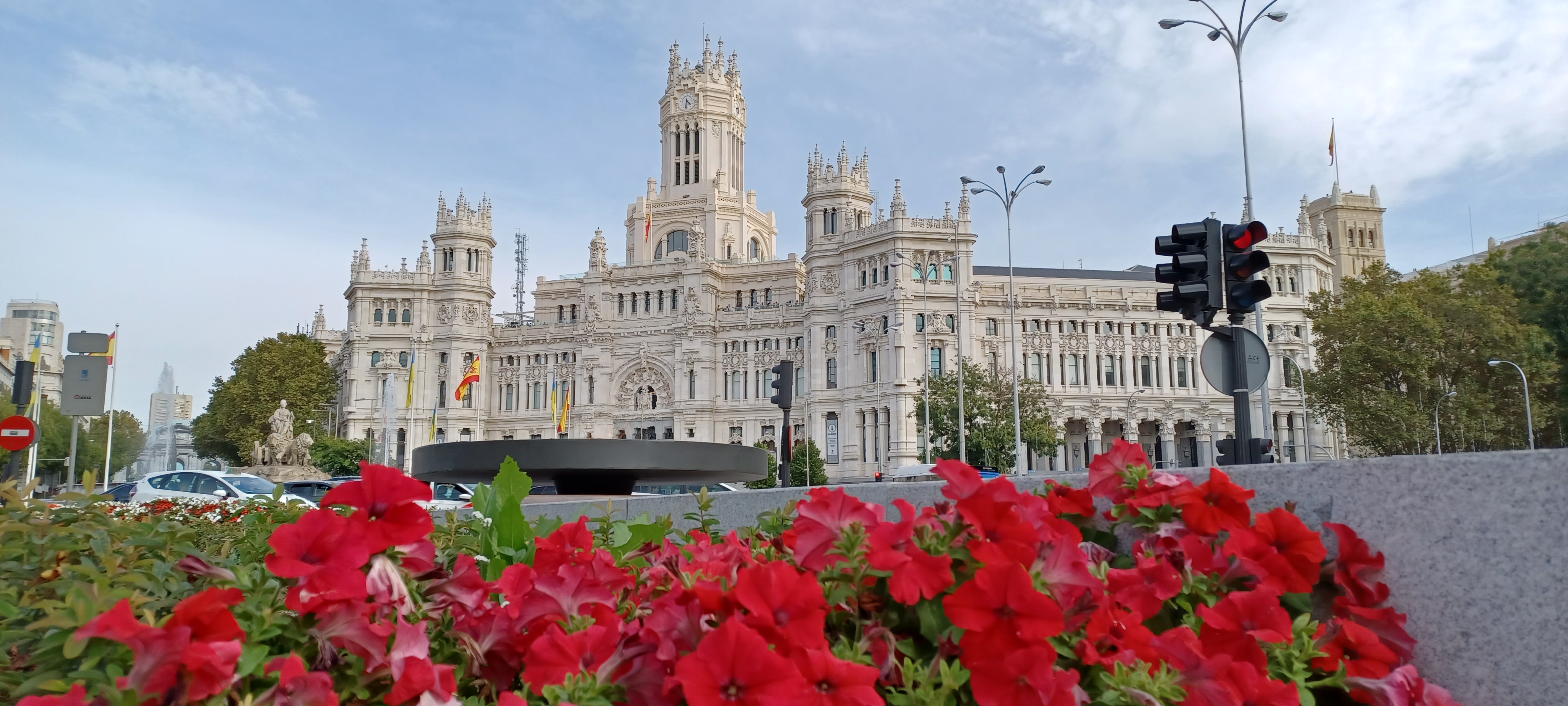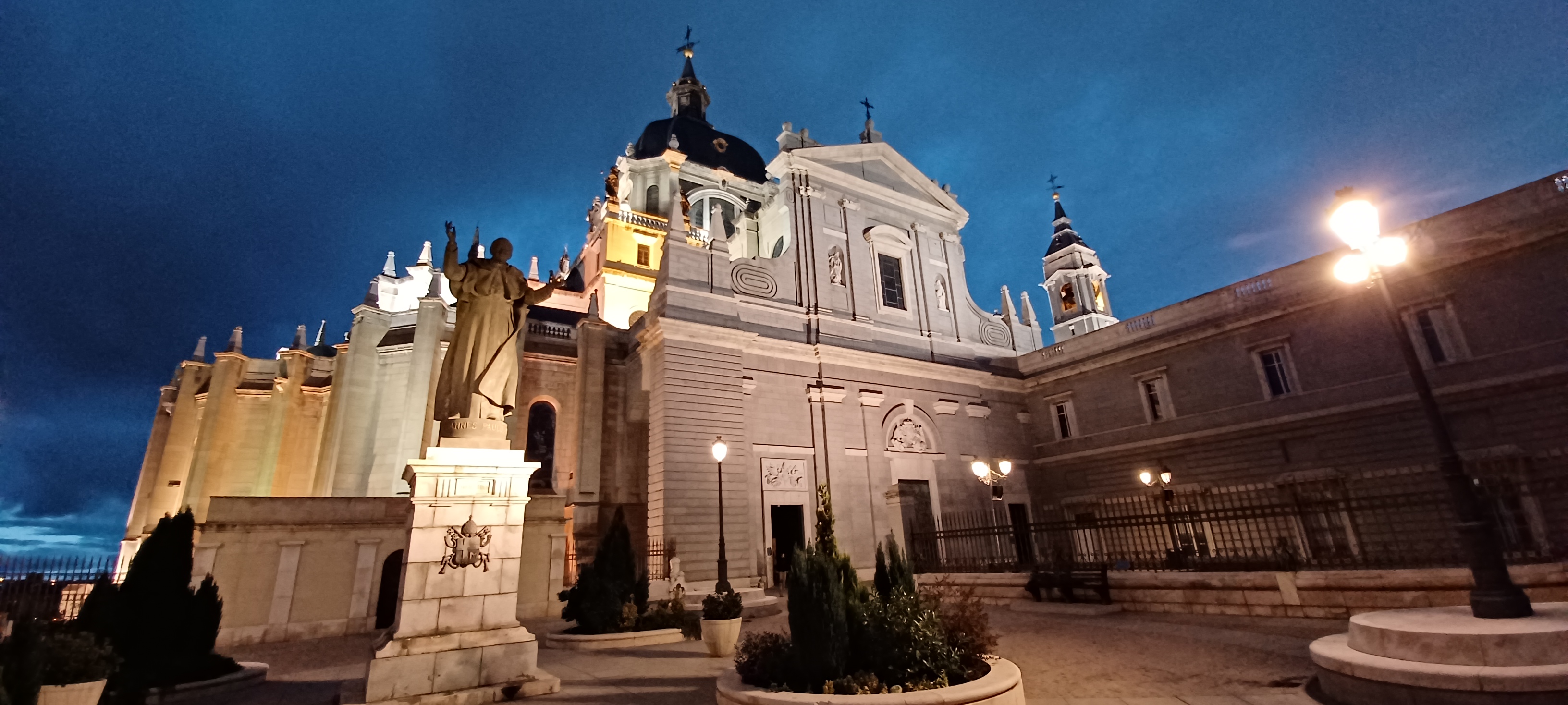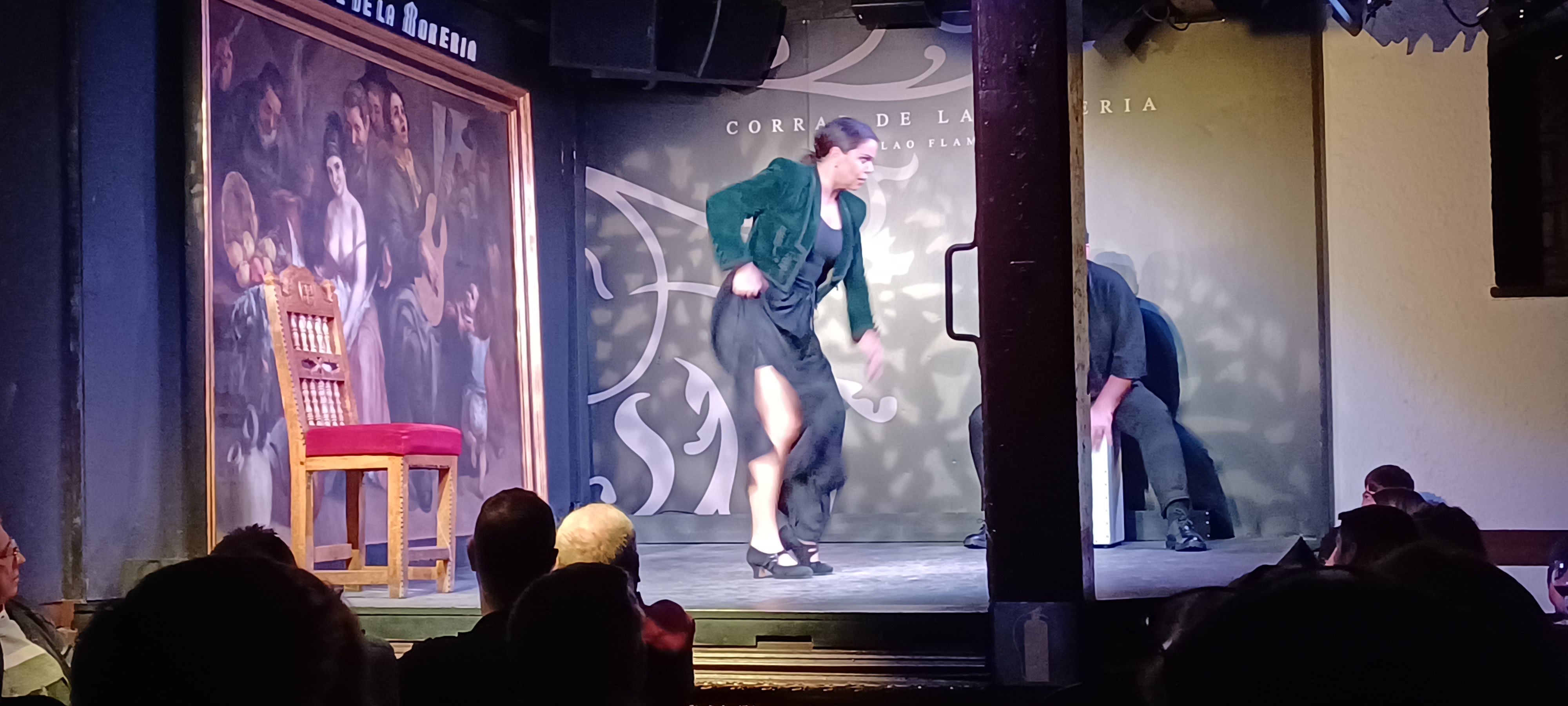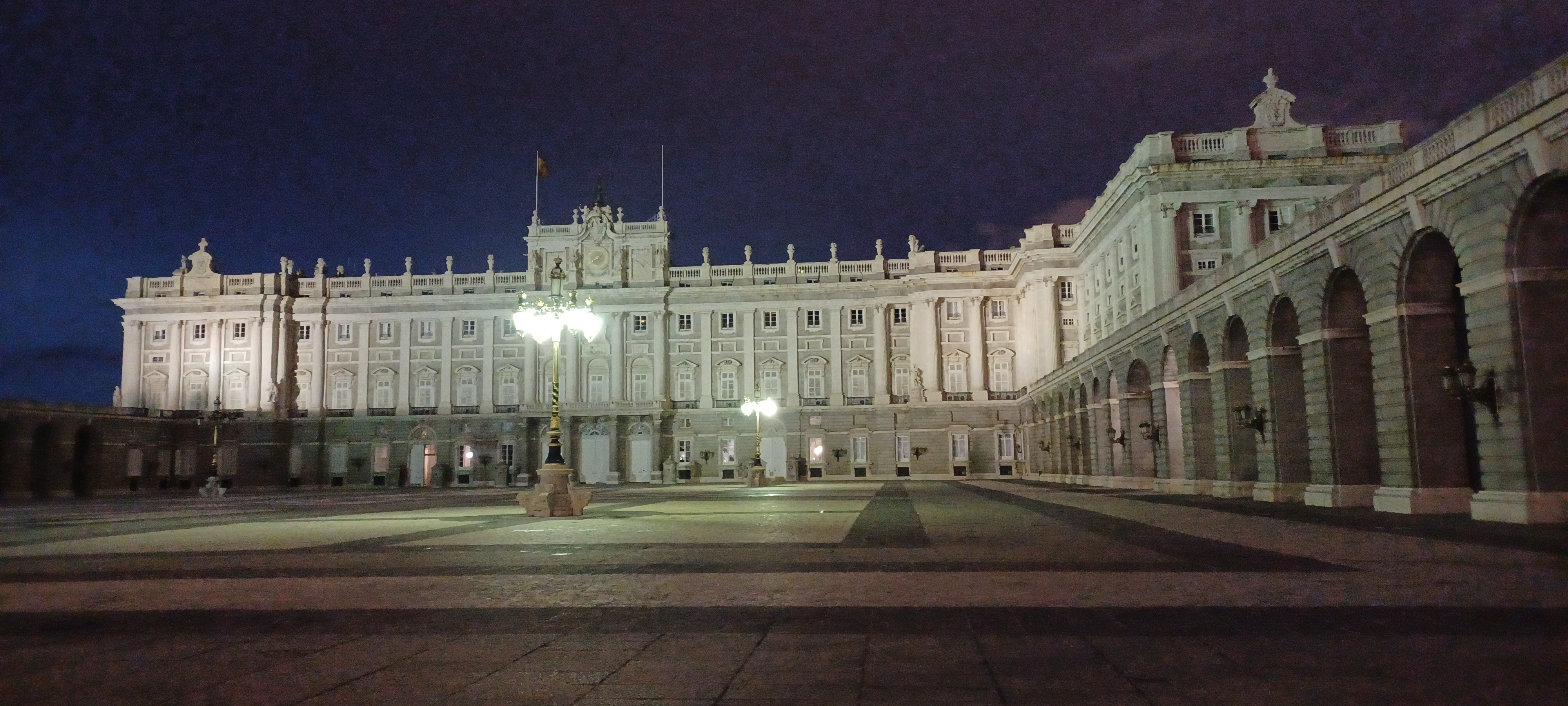| SPAIN |
| SPAIN | Picture Description |
|
Barcelona, Spain Sagrada Familia In 1884 Antonio Gaudi completes the crypt at the Sagrada Família (the crypt had been started by the architect Francisco del Villar in 1882, who had to abandon the project in 1883. Gaudi became reluctant to talk with reporters in his later years or have his picture taken and solely concentrated on his masterpiece, La Sagrada Família. He spent the last few years of his life living in the crypt of the "Sagrada Familia" |
|
Barcelona, Spain A Wall of of Grafitti in Barcelona |
|
Barcelona, Spain A mounted police officer at Plaza de Espanyol |
|
Barcelona, Spain People making a sign |
|
Barcelona, Spain Chef at a restaurant near Plaza de Espanyol |
|
Barcelona, Spain The Musical Fountain at MNAC M.useo N.acional de A.rte de C.ataluna. |
|
Barcelona, Spain Paella at Sukaldari restaurant at 87 Ramblas. The food was good. Though comparisons with Paella dishes from other restaurants reveal that the Paella at Sukaldari is rather dry. Paella was originally a laborer's meal, cooked over an open fire in the fields and eaten directly from the pan using wooden spoons. Snails were the most commonly used meat as they were cheap. Special occasions warrented rabbit or duck and the well off would have chicken. The origins of Paella did not involve seafood. A typical Paella dish might include meat, olive oil, pepper, onions, garlic, parsley, tomatoes, short grain Spanish rice, saffron, and water. |
|
Barcelona, Spain A cat enjoys the view from a park bench at Park Guell Park Guell is a garden complex located at the hill of el Carmel in the Gracia district of Barcelona. It was designed by antoni Gaudi and built between 1900 to 1914. It is a UNESCO World Heritage Site. Park Guell is skillfully designed and composed to bring the peace and calm characteristic of Gaudi's works that try to reconcile natural lines and harmony of architectural elements. |
|
Barcelona, Spain The view of Barcelona from Park Guell. Park Guell was designed by Antonio Gaudi. The park was originally part of a commercially unsuccessful housing site, the idea of Count Eusebi Güell, whom the park was named after. |
|
Barcelona, Spain A "headless" performer at Park Guell |
|
Barcelona, Spain Children at the famous lizard sculpture at Park Guell Antoni Plàcid Guillem Gaudí i Cornet lived from 1852 to 1926. he was a Spanish Catalan architect. His use of mosaic tiles in his architecture is very characteristic of his works. The lizard was vandalized in 2007. |
|
Barcelona, Spain A Pidgeon at a water fountain in Park Guell. Pidgeons nest in the Palm Trees. |
|
Barcelona, Spain Cello and Violin performer in the collonades in Park Guell |
|
Barcelona, Spain Cars in Spain are smaller than the typical car in the USA. |
|
Barcelona, Spain A typical street in Barcelona |
|
Barcelona, Spain Casa Mile (la Pedrera) designed by Antonio Gaudi, a UNESCO World Heritage site. Gaudi's style of architecture is known as the modernist style. (Art Noveau) |
|
Barcelona, Spain The Grand Theater at Liceu was designed by Miguel Roca and Josep Mestres. It is an opera house on La Rambla street and opened on April 4, 1847. It is currently a public theater with a capacity of 2,292 seats on 6 levels. The building succumbed to a fire in 1861 and was rebuilt by architect Josep Mestres. It reopened in 1862. |
|
Barcelona, Spain The Cathedral of of Santa Eulalia. It is a gothic cathedral and seat of the Archbishop of Barcelona. It was made from the 13th to 15th centuries. It was completed in 1450. The neo-gothic facade was constructed over the original exterior. It was built over the crypt of a former Visigothic chapel, dedicated to Saint James. It is a hall church, vaulted over five aisles the outer two divided into chapels. |
|
Barcelona, Spain The Plaza de Catalunya (Catalonia) The Palza Catalunya is where the old city (Barri, gotic, Raval, and Ciutat Vella) and the 19th century Barcelona Eixample meet. Major roads converge at this 538,195 square feet square. It has numerous fountains and statues. A huge flock of pidgeons grace the center. |
|
Barcelona, Spain A statue in Barcelona |
|
Barcelona, Spain The Joan Miro Park Joan Miro was born in Barcelona in 1893 and studied Fine arts at the academy Gali. He created works similar to Catalan folk art and was influenced by Cubism. He moved to Paris and studied there in the 1920 and developed his signature style, Surrealism. He experimented with Painting, Etchings, Lithographs and Ceramics. He died in 1983. |
|
Barcelona, Spain Many people hang clothes out to dry. This picture was taken in February, 2010. |
|
Barcelona, Spain Pueblo Espanyol (The Spanish village) de Montjuic. This village was built in 1929 for the Barcelona International Exhibition. It brings together traditional architectural styles from all over spain and houses handicraft and souvenir shops. The Spanish Village is on the avenida Marques de Comillas going up Montjuic. You can visit the official site at Poble Espanyol |
|
Barcelona, Spain A glass-blower at Pueblo Espanyol. He is making a glass apple which starts off as a slag of of glass which is shaped by hand into an apple. another dab of molten glass adds the stem which is drawn up from the core, than a cast iron stamp is used to imprint a leaf. |
|
Barcelona, Spain A person weaving scarves at Pueblo Espanyol. (The scarves are will be at least 80 Euros at 1.37 $/Euros) |
|
Barcelona, Spain The status called "Couple" by Cyril Mendjisky 1999, welded metal. 200x200x100 cm |
|
Barcelona, Spain The Telefonica transmission tower at the Olympic stadium |
|
Barcelona, Spain A performance hall at the Olympic Stadium complex |
|
Barcelona, Spain The Olympic Stadium at Montjuic (Estadi Olimpic de Montjuic) for the 1992 Olympic games. The 1992 Summer Olympic Games, Games of the XXV Olympiad were an international multi sport event held at Barcelona. The Motto was "Amigos Para Siempre (Friends Forever)" The Olympic flame cauldron was lit by Paralympic archer antonio Rebollo. Following Germany reunification in 1990, Germany sent a single unified Olympic team for the first time since 1964. The Soviet Union dissolved in 1991, Estonia, Latvia and Lithuania sent their own teams for the first time since 1936. The break up of Yugoslavia cause the debut of Croatia, Slovenia and Bosnia & Herzegovina teams. |
|
Barcelona, Spain The World Trade Center It is located in Port Vell. It has a 64583 square foot congress and Convention Center. It houses the offices of more than 100 business and 25 shops and service companies. It also is the home of the Eurostar Grand Marina Luxury Hotel. |
|
Barcelona, Spain The Columbus Colonade. There are 77 monuments around the world dedicated to Christopher Columbus but the one in Barcleona is the largest. Born 1451 died 1506. Born in Genoa Italy, Son of Domenico Colombo. In August 3, 1492 he left Palos de la Frontera with Santa Maria, Pinta and Nina. Land was sighted October 12, 1492. He landed in the Bahamas which he called San Salvador. The natives called it Guanahani. (It could correspond to Samana Cay, Plana Cays, or San Salvador island). He encountered the indigenous Lucayan, Taino, Arawak. He made 4 voyages to the new world and his last voyage he was in search of the Strait of Malacca to the Indian Ocean made in 1502. |
|
Barcelona, Spain Mare Magnum, a modern shopping plaza |
|
Barcelona, Spain A gunboat at the World Trade Center |
|
Barcelona, Spain A building at the pier near the World Trade Center |
|
Barcelona, Spain Modernist statue in Barcelona |
|
Barcelona, Spain Statue |
|
Barcelona, Spain Music Center Palace. It is a UNESCO World Heritage site. The Palau de la Musica Catalana is a concernt hall designed by Lluis Domenech i Montaner. It was built between 1905 and 1908 for Orfeo Catala a choral society founded in 1891. It was inaugurated Feb 9 , 1908. It was financed primarily by the Choral Society. It won the award for best building in 1909. It was declared a UNESCO World Heritage site in 1997. It is located at Carrer de Sant Francesc de Paula street in La Ribera. The design is typical of Catalan modernism with curves that predominate over straight lines, dynamic shapres preferred over static forms, and rich decoration emphasizing floral and organic motifs. It also is a functional building and utilized the latest in available material technoloiges. |
|
Barcelona, Spain A typical street in Barcelona |
|
Barcelona, Spain The Arc de Triofe (The Triumph Arch) It was built for the 1888 Universal exhibition designed by architect Josep Vilaseca i Casanovas. It was built in moorish Revival style. The front frieze contains the stone sculpture "Barcelona rep les nacions" (Barcelona welcomes the nations) created by Josep Reynes. The top of the arch is decorated with the coat of arms and the representation of all 49 other Spanish provinces of Torquat Tasso and Antoni Vilanova. It is located between Passeig de Lluis Companys and Passeig de Sant Joan. |
|
Barcelona, Spain Statue at the opposite end of the Arc de Triumph called the Park of the Ciutadella. The park was built in the 1860s and covers an area of 18 hectares. It is open daily and has a zoo, a lake, a large fountain and several museums. |
|
Barcelona, Spain Performers at the Arc de Triumph |
|
Barcelona, Spain The Glories Building in Barcelona |
|
Barcelona, Spain It is the Hospital de la Santa Crau i Sant Pau (Catalan for Hospital of the Holy Cross and Saint Paul). It is a UNESCO World Heritage site. It is in the El Guinardo neighborhood it was built between 1901 and 1930. Designed by the Catalan Modernist architect Lluis Domenech i Montaner. It was a functioning hospital until June 2009 and now it is a museum and cultural center. It was founded in 1401 when six small medieval hospitals merged. It was awarded with the 1991 Creu de Sant Jordi by Generalitat de Catalunya. |
|
Barcelona, Spain The Subway map of Barcelona The Barcelona Metro is part of the public transporatation system using electric trains. By 2014 it will have 11 lines and 209 stations with 124 miles of track. In Dec 13, 2009 it had 10 lines, 152 stations and 70.2 miles of track. |
|
Barcelona, Spain Sagrada Familia at sunset. As of 2010, completion of the Sagrada Familía is planned for 2026, which would be the 100th anniversary of Gaudí's death. Gaudí's first works were designed in the style of gothic architecture and traditional Catalan architectural modes. Gaudí spent ten years working on studies for the design of La Sagrada Família and developing a new method of structural calculation based on a model built with cords and small sacks of lead shot. |
|
Barcelona, Spain Dancers at the Catedral of Barcelona |
|
Barcelona, Spain Rental bicycles |
|
Barcelona, Spain People in the Subway |
|
Barcelona, Spain A person doing laundry |
|
Barcelona, Spain The Casa Vincens. This home was designed by Antonio Gaudi in 1883. It is one of Gaudi's first building/home designs. |
|
Barcelona, Spain The Metro (Tram) On 7 June 1926 Gaudí was run over by a tram. Because of his ragged attire cab drivers refused to pick him up. He was eventually taken to a paupers' hospital in Barcelona. Nobody recognized him until his friends found him the next day. When they tried to move him into a nicer hospital, Gaudí refused, reportedly saying "I belong here among the poor." He died three days later on 10 June 1926, at age 73, half of Barcelona mourning his death. He was buried in the midst of La Sagrada Família. |
|
Barcelona, Spain The Palau Reial (Royal Palace) entrance Antonio Gaudi's first works were the lamp posts for the Royal Palace. |
|
Barcelona, Spain The Palau Reial de Pedralbes (Royal Palace) The palace was built in 1921 as a residence for King Alfonso XIII. Its gardens were designed and built in 1924 by the landscape architect rubio i Tuduri. The palace has two museums, the Museu de les Arts Decoratives and the Museu de Ceramica features exhibits from ancient Arab ceramics to pieces by Picasso and Miro. In 1997 the palace was the wedding banquet place for Infanta Cristina daughter of King Juan Carlos. It is located in Avinguda Diagonal. Alfonso XIII (Alfonso Leon Fernando María Jaime Isidro Pascual Antonio de Borbon y Austria-Lorena) He was born in Madrid, May 17, 1886. He died in Rome, 28 February 1941. He was the King of Spain reigning from 1886-1931. His mother, Queen Maria Christina, was appointed regent during his minority. In 1902, on attaining his 16th year, the King assumed control of the state. |
|
Barcelona, Spain The Pergola at the Palau Reial by Antonio Gaudi The parabolic Pergola is covered with climbing vines. |
|
Barcelona, Spain The Hercules Fountain at Palau Reial by Antonio Gaudi The fountain of Hercules is in a small bamboo forest created from wrought iron and stone. It was created by Antoni Gaudi in 1884 and made for the property that the Guell family had in Pedralbest, part of the lands ceded for the construction of the new royal Palace of Barcelona. It was hidden under dense vegetation for many years and its existence was not discovered until 1984. There is a bench carved from stone on both sides and a marble bust on the pedestal from which the dragon head emerges. It was placed there in 1984 to replace the original, when the fountain was discovered and restored one hundred years after its construction. |
|
Barcelona, Spain The Dragon door at the entrance to the Guell residence Eusebi Guell came to know of Antonio Gaudi at the 1878 World's Fair in Paris. He eventually becomes the patron of Antonio Gaudi. |
|
Barcelona, Spain A slot machine at a restaurant. |
|
Barcelona, Spain A cigarette machine at a restaurant |
|
Barcelona, Spain Casa Batllo (The Batllo Home) designed by Antonio Gaudi. |
|
Barcelona, Spain Subway train pulls into the station. Note the digital readout board. Casa Batllo is a building restored by Antoni Gaudi and Josep Maria Jujol. It was built in 1877 and remodeled in 1904-1906. It is located at 43 Passeig de Gracia in the Eixample district of Barcelona. The local names for the building Casa dels ossos (House of Bones) because of its skeletal organic quality. It is designed in the Modernisme Art Nouveau. There are few straight lines and decorated with a mosaic facade of broken ceramic tiles. The roof is arched and likened to the back of a dragon or dinosaur. The turret and cross represents the sword of Saint George (patron saint of Catalonia) plunging a sword into the back of the dragon. |
|
Barcelona, Spain Dinner at Los Caracoles (Paella, Monkfish) |
|
Barcelona, Spain The Balearia pulls into the harbor near Mare Magnum |
|
Barcelona, Spain Music Center Palace (UNESCO World Heritage site) |
|
Barcelona, Spain A painting by Picasso at the Picasso Museum. In 1908 Picasso invents Cubism. Pablo Diego Jose Francisco de Paula Juan Nepomuceno María de los Remedios Cipriano de la Santísima Trinidad Ruiz y Picasso was born October 25, 1881 and died April 8, 1973. Pablo was a Spanish painter, draughtsman, and sculptor. He is best known for co-founding the Cubist movement in art. He entered an art contest at 15. He had incredible artistic talent manifesting at an early age. His most famous works are Les Demoiselles d'Avignon (1907) Guernica (1937) and Weeping woman (1937). |
|
Barcelona, Spain Barcelona Airport |
|---|---|
| Madrid Spain Oct 2022 |

|
Madrid, Spain The PLAZA DE CIBELES is a square in Madrid with a neo-classical complex of marble sculptures with fountains that has become a symbol for the city of Madrid. It is at Calle de Alcalá, Paseo de Recoletos and Paseo del Prado. It was originally called Plaza de Madrid, renamed to Plaza de Castelar (1900), and then replaced by its current name. It has four key buildings: the Bank of Spain Building, the Palacio de Buenavista, the Palace of Linares, and the Cybele Palace ("Palacio de Cibeles") located in four different neighbourhoods from three different adjacent districts: Centro, Retiro, and Salamanca. |

|
Madrid, Spain The PUERTA DE ALCALÁ is a Neo-classical gate in the Plaza de la Independencia. It was a gate of the former Walls of Philip IV. It is at the city center near the entrance to the Parque del Buen Retiro. It is bisected by Alcalá Street. It was inaugurated in 1778. Its name originates from the old path from Madrid to the town of Alcalá de Henares. In 1774 CE, King Charles III commissioned Francesco Sabatini to construct a gate in the city wall through which an expanded road to the city of Alcalá was to pass, replacing the older gate. The ornamental details were sculpted by Francisco Gutiérrez and Roberto Michel, and made of white stone from Colmenar. The architectural elements are made of Segovian granite. |

|
Madrid, Spain ALMUDENA CATHEDRAL (Santa María la Real de La Almudena) is a Catholic church in Madrid, Spain. It is the seat of the Roman Catholic Archdiocese of Madrid. The cathedral was consecrated by Pope John Paul II in 1993. |

|
Madrid, Spain RESTAURANTE CORRAL DE LA MORERIA It has been awarded as Awarded as the "World's Best Flamenco Tablao" by the International Cante de las Minas Flamenco Festival. Corral de la Morería is perhaps the world's most famous and prestigious flamenco tablao. It opened in 1956. Every night since it has provided a unique experience with a high quality artistic program and culinary experience. It is in the 1,000 Places to See Before You Die, a New York Times compilation of the most iconic places on Earth. |

|
Madrid, Spain The ROYAL PALACE OF MADRID is the largest royal palace in Western Europe and one of the largest in the world. With over 135,000 square metres and 3,418 rooms, it has witnessed centuries of Spanish history. It is one of the few official seat of a Head of State that is open to the public. The palace is owned by the Spanish state and administered by the Patrimonio Nacional, a public agency of the Ministry of the Presidency. The interior of the palace is notable for its wealth of art and use of fine materials in its construction and decoration. |
|
Madrid, Spain The PRADO MUSEUM, officially known as Museo Nacional del Prado, is the main Spanish national art museum, located in central Madrid. It is widely considered to house one of the world's finest collections of European art, dating from the 12th century to the early 20th century, based on the former Spanish Royal Collection. It has the best collection of Spanish art. It was founded as a museum of paintings and sculpture in 1819. The Prado Museum is one of the most visited sites in the world, and considered one of the greatest art museums in the world. Works by Francisco Goya, the single most extensively represented artist, and by Hieronymus Bosch, El Greco, Peter Paul Rubens, Titian, and Diego Velázquez, are some of the highlights of the collection. Velázquez and his keen eye and sensibility were responsible for bringing much of the museum's fine collection of Italian masters to Spain. The collection currently has 8,200 drawings, 7,600 paintings, 4,800 prints, and 1,000 sculptures. As of 2012, the museum displayed about 1,300 works in the main buildings, while around 3,100 works were on temporary loan to museums and institutions. Due to the COVID-19 pandemic, in 2020 attendance plunged by 76 percent to 852,161. But it was ranked as the 16th most-visited museum in the world in 2020. It is one of the largest museums in Spain. The Prado, with the nearby Thyssen-Bornemisza Museum and the Museo Reina Sofía, forms Madrid's Golden Triangle of Art, which was included in the UNESCO World Heritage list in 2021. |